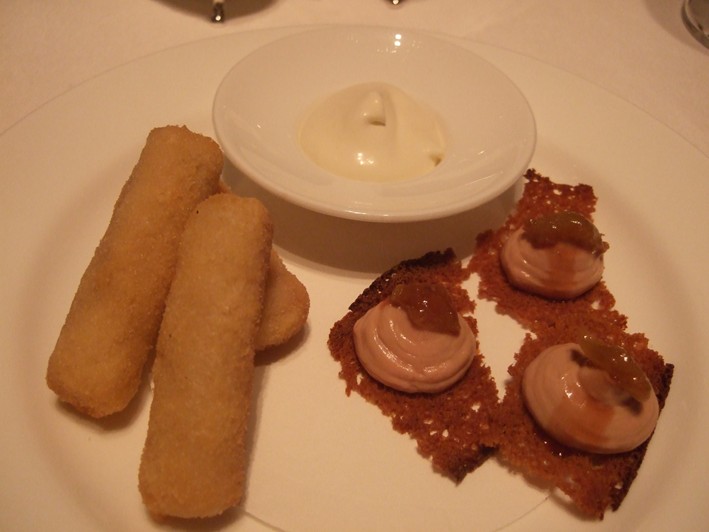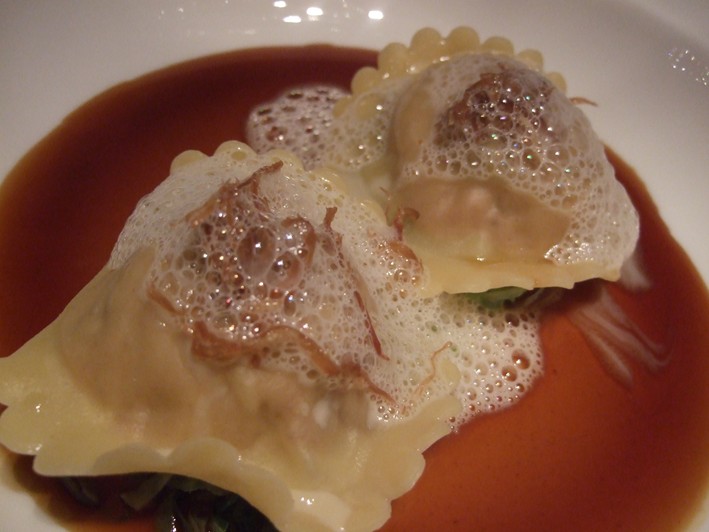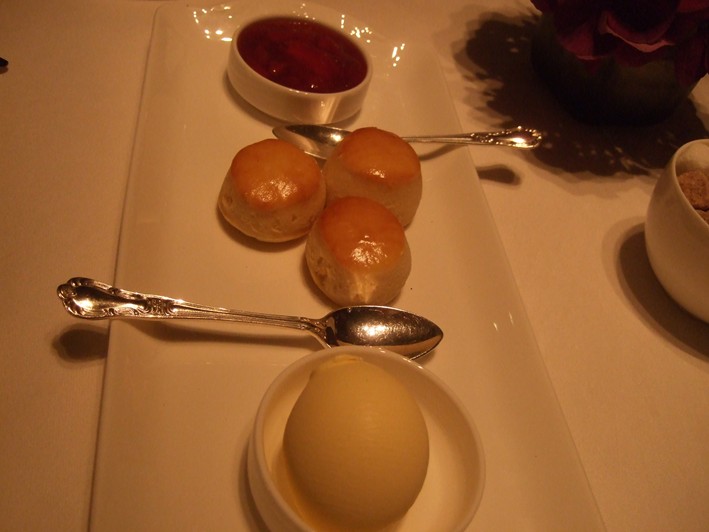Editor's note. Please be aware that the association of this restaurant with Gary Rhodes ceased on 28th September 2012. It will not reopen. Consequently the notes below should be regarded as of historical interest only.
The restaurant has a separate entrance to the Cumberland hotel, up a few steps with a silver-studded black door leading through a corridor, past the wine cellar, into a bar area. Through this is the main dining room, screened off from the bar by two rather unappealing black screens that reminded me of the shutters used to protect shop fronts after dark in dodgy bits of east London. This aside, the décor is tasteful if a little cold, with beige carpets, upholstery and walls, high ceilings with several lavish chandeliers. Lighting from these is good, supplemented by additional ceiling spot lights. On one wall are several large wood-framed mirrors. Each table has crisp linen tablecloths and napkins, and a single orchid. Rather unnecessarily there is muzak, and oddly chosen muzak at that – personally I don’t want to my dinner to be accompanied by rap music, and even if I did it is wholly out if tune (in more ways than one) with the surroundings.
The menu was appealing, with plenty of classic taste combinations on offer, and three courses at £60. The wine list was 14 pages in length, and although there was a large French section, the rest of the world was represented too. JJ Prum Auslese Wehlenher Sonnenuhr 2005 was listed at £85 (retail around £29), Vega Sicilia Unico 1989 at £390 (retail £180), and Ostertag Riesling Grand Cru 2004 at £72 (retail around £18). House wine is available by the glass from £8. There is very little on the list under £40.
We began with a nibble of gravadlax on dill toast with honey and mustard dressing, with a little stick of puff pastry (supposedly flavoured with tapenade, but this was subtle, to put it mildly) and a goat cheese curd to dip it in. The gravadlax was good and indeed each component was fine, but this flavour combination seemed to me quite contrived (15/20). A further nibble was a spoon of mushroom duxelle which had strong mushroom taste, next to a tempura of duck with a mango and (mild) chilli dipping sauce. Again, the individual components seemed better in isolation than as a whole: the tempura could have been lighter but the duck inside was tender, but I cannot see really see the logic of the taste combination (15/20). A final nibble of gazpacho had a nice peppery kick, though the tomatoes it was made from had decent rather than great taste; a little crab meat on toast with this at least made a summery combination (15/20). Bread was made from scratch here, and is a choice of white or brown rolls, pleasantly seasoned (16/20).
My starter was a trio of scallops with baby asparagus and a broad bean soup. The scallops had been seared with a little curry powder and Parmesan and were of high quality, plump and moist. The soup had plenty of broad bean flavour and the asparagus was tender (16/20). A “crisp soft egg” was served on a bed of mushroom duxelle, with two fingers of Roquefort truffle toast. The egg was an example of innovation without the necessary skill: the egg was cooked a little too lightly, leaving some raw white, then deep fried to provide the “crisp” texture. Unfortunately the effect was to give the egg a texture of chewiness. The duxelle was fine, as was the toast (other than a little slip in the kitchen which had resulted in one piece of toast tasting nicely of Roquefort, the other seemingly having missed out entirely on the cheese). Quite what a pea shoot garnish was doing here other than pea shoots being trendy is unclear: 14/20 only.
A large fillet of halibut was well timed, served with crab tortellini with pleasingly soft texture (though light on crab flavour) and a good shellfish bisque. With this were buttered leeks and a little bacon. This dish seemed to have a flavour too many but it was nicely made (15/20). I played safe with fillet of beef on a bed of spinach and a sliver of rosti, served with artichoke, foie gras and truffled Maderia jus, topped with a soft quail’s egg. This was quite a rich dish, again showing a tendency to over-complicate (what was the quail egg doing?) but the technique was good: the beef was properly cooked, the artichokes were tender, the foie gras excellent. The rosti had become a little soggy in the jus and the beef was very good rather than outstanding (the beef at Maze grill or Hawksmoor is superior) but overall this was a successful, classical dish – something with a little acidity would have been useful in place of the egg perhaps (16/20).
Cheese was displayed on a proper trolley and was from Paxton & Whitfield and Premiere Cheese. Camembert was in excellent, runny condition and the pick of the board, while Puligny Saint Pierre was ripe (15/20), Beaufort was rich in flavour, Tartufette (flavoured with truffle) was unusual, while the semi-soft Irish Crozier blue did not seem to me to benefit from being steeped in red wine. A walnut and raisin bread or biscuits were offered, and the cheese was served with a few grapes. This was certainly a good board, and the Maltese waitress was very knowledgeable about the cheeses (16/20).
A plate of lemon desserts had a zingy lemon chiboust (a pastry cream with meringue), lemon tart with pleasingly soft pastry and well balanced filling, lemon panacotta and a few raspberries as garnish. So far, about 16/20, until I tasted a sugared beignet, which was so rubbery it defied being cut with a spoon and fork. It had roughly the consistency of a squash ball, and was clearly made a long time in the past rather than being fresh. This was a bizarre technical slip, and when I mentioned this to the manager his response was interesting. He poked it with a fork and said “yes, this is still a problem; I told the kitchen about this earlier”. In that case why serve it?
By contrast a passion fruit soufflé showed excellent technique, served with intense passion fruit coulis and an excellent dark chocolate sorbet with very clean and strong chocolate taste (17/20). Coffee was fine and at £5 so it should be), served with a pleasant orange sponge-cake, a decent mint chocolate and a less well-judged salted caramel that was significantly oversalted.
Service was attentive throughout the evening, and dishes arrived at a steady pace. Overall, ingredients were quite good, presentation generally quite pretty, and technique was mostly consistent other than some minor but jarring clangers (especially the dismal beignet). The cooking seemed best when it stuck to the classic, such as the beef and the soufflé, and on much less certain ground when it came to trying to match more exotic flavours, or trying to show off (but getting it wrong) as with the egg starter. The bill was £124.25 per person, with no pre-dinner drinks, no dessert wine but a £79 bottle of Riesling and a single glass of red wine. This seems to me just a little much. The ambition level is fairly high and you certainly get plenty of nibbles thrown in, but at these prices I don’t expect a beignet that bounces.
Here is a meal soon after opening, in June 2007, by way of comparison.
You enter through an imposing black door into a discreet dining room with plenty of chandeliers and well spaced tables. There is a beige carpet on the floor and no music (on this lunch time visit), allowing for conversation, which is a nice change from so many places these days with their wooden floors and music, forcing you into a strained conversation with your fellow diners that resembles trying to chat at a disco. The service was formal but very careful, dishes arriving in a timely way, topping up faultless. The menu offers a wide range of options. There was a broad a la carte at £45 for three courses (£39.50 for two courses) a significantly cheaper, more limited, lunch menu, and a tasting option. This has the appealing idea of a menu of choices from which you can make up your own tasting menu of, say, four dishes. I like this notion, as so often with the chef's tasting menu I find a dish or two I wouldn't really have chosen. These tasting size dishes were around £11 and can also act as an intermediate course. The wine list was well put together but mark-ups were quite high, and the growers somewhat obscure in some cases. There was little relief under £40.
An amuse-bouche had a very good deep fried eel and little blobs of foie gras terrine (15/20). Bread was a single choice of small white rolls, served warm (14/20). I began with warm scallops and langoustines with a caviar hollandaise. The scallops were cut up into cubes, which I seemed an odd thing to do as they seem to me best cooked whole, and in fact there was virtually no langoustine at all; langoustines are expensive but this seemed rather mean given this was an a la carte dish. The hollandaise was well made and the shellfish cooked well enough, but for me this was 13/20 territory. Better was a nicely timed piece of steamed turbot, served on a bed of buttered baby leeks and three pieces of ravioli of mackerel. The pasta had good texture and the leeks were fine, though again this dish rather lacked excitement: the turbot and leeks were a little bland as a combination, and the mackerel could have given a welcome extra dimension but itself was subdued in taste (13/20).
Better were desserts, a nicely made and presented lemon chiboust served with some good quality in-season raspberries (15/20). A millefeuille of dark chocolate and orange had a pleasant mousse, and a sorbet of kumquat gave a welcome element of acidity to balance the richness of the chocolate (14/20). Coffee was of high quality (16/20) served with an unusual touch: some home-made scones and strawberry jam. Overall this was a very pleasant experience, and the quiet, spacious room would make it well suited for business lunches where you could have a discreet conversation. It was a little costly for the level of cooking, however.




















Add a comment
Thank you for submitting your comment, this will be checked and added to the website very soon.
User comments